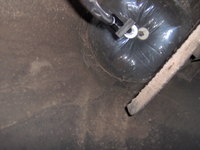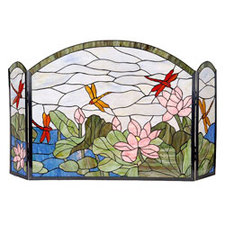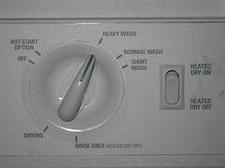
by blogediter | May 21, 2018 | Chimney Plugs
Chimney Balloon
Q: Jason, My wood burning fireplace has an 8-inch chimney pipe. Am I correct that the 9×9 inch Chimney Balloon would be the correct size? – DS
A: Dear DS, Thank you for your interest in the Chimney Balloon for a chimney plug for this 8″ chimney pipe. You are exactly right. A 9X9 Chimney Balloon is made specifically for the 8″ chimney pipe application. You will find it fits perfectly. See the picture with this post.- Jason

by blogediter | May 18, 2018 | Chimney Plugs
Fireplace Cover
Q: Jason – I too am struggling with two fireplaces built in 1970’s that are old and too costly to repair the brick seal. I can smell the draft odor and me confident now that my master bedroom temperature is fluctuating due to the fireplace. I can’t see a safer solution anywhere, “The Great Stuff” seems ok but not perfect and not safe. Once I order your Chimney Balloon how do you suggest to clean the brick inside so it ends up looking nice and where can I find a decent fireplace cover? – BMM
A: BMM, The Chimney Balloon will certainly help stop the chimney odor and the temperature fluctuations in the room, but not with the looks of the fireplace, as the Chimney Balloon is designed to be installed up out of eyesight in the flue.
You could try cleaning the bricks with a brick cleaner. Rutland Products has one that is available at Ace Hardware or fireplace shops and I have heard muriatic acid works as well. Be very careful with these cleaners though and follow their instructions closely.
If you want a more decorative touch you can go with a fireplace cover or fireplace shield as you suggested. You will likely find those online through retailers like Northline Express or Woodland Direct and they will be listed under fireplace screens. I have attached a picture of a Tiffany style fireplace shield cover that retailed for $200. There are many styles to chose from and plenty of vendors who sell them online. – Jason
by blogediter | May 16, 2018 | Save Energy
Q: The Chimney Balloon website says that it can save a homeowner up to 30% on the home heat. How do you get this figure?
A: The 30% savings is if you have no damper on your fireplace or if the damper is stuck open. The Department of Energy estimates a home with no damper on the fireplace will increase its heating bill 30%. The DOE website mentions the Chimney Balloon in an indirect way on the website as an “inflatable stopper” See this link here: http://www.eere.energy.gov/consumer/your_home/space_heating_cooling/index.cfm/mytopic=12570
Below is the quote from the DOE website:
“Flues are ideal for leaking heat and warm air out of your home. If you have a fireplace that you don’t use, plug and seal the flue. If you use the fireplace, be sure to close the flue when the fireplace is not in use. You could also use an inflatable stopper, available commercially, to temporarily seal the chimney and avoid air leakage through the flue.”
The above quote is Copyright property of the US Department of Energy.
Your heat savings will be less than 30% if you do have a functioning damper, but even the best of metal dampers are often only 75% efficient since they have no insulation and they conduct cold. Most used metal dampers are less than 50% efficient due to warping and corrosion.
by blogediter | May 16, 2018 | Chimney Plugs
Q: How can I get more heat out of my wood burning fireplace during use? – SB
A: We already went over some ways to improve your fireplace’s efficiency while it is dormant and not being used. Let review some steps on how a person can get more useful BTUs from their fireplace during the burn. I will rank the improvements in estimated efficiency and cost.
1) Burn Dry Wood:
You would be surprised how much energy and BTUs are robbed from a fire if you are using under seasoned wood. Most hard woods will properly dry after 24 months of being stacked in a dry environment with at least some air circulation (ie a yard shed or a garage. Some more dense and sappy wood can take longer. I had some small Cherry wood logs in my shed for 16 months that was still not ready to burn. Some red oak was stacked next to the cherry wood and seasoned for the same amount of time, to it that was all set to go. Wood that has too much moisture tends to bubble and sizzle when burned and also it creates a terrible moist creosote collection that is hard on your chimney. It often also makes the room smell bad after it is burned and occasionally it will not burn all the way down to ashes.
Efficiency increase: up to $15 percent
Cost: $0 just takes some time.
2) Iron Firebacks
Iron Firebacks have been used to cast radiant heat from a fireplace into a room for centuries. Some more recent developments in stainless steel have some manufacturers making lightweight stainless firebacks that work the same as their heavy antique counterparts do. Firebacks work in two ways they retain and release heat after the fire has gone down. and they help to reflect heat outward during the warmest part of the burn. They are not terribly effective at real energy savings but they are certainly better than nothing.
Effectiveness: 5% to 7% increase in useful BTUs
Cost: $200-$300 shipped.
3) Heatalators
This is a brand name for a product that is made by many different manufacturers and often referred to as a great heater. The concept is usually the same though. Some steel tubes with an internally mounted fan are mounted or set in the fireplace around the location of the burn. The tubes heat during the burn and a fan blow the heated air through the tubes and out into the room. They are mildly effective at harnessing the BTUs that the fire would normally spit out the chimney. They also allow a person to keep the glass doors of the fireplace closed and still enjoy the heat of the fire.
Efficiency: increase 15%-25% useful BTUs
Cost: $300-$600
Learn more about how to save energy when your fireplace is dormant: http://www.chimneyballoonusa.com/blog/2007/01/how_can_i_help_.html

by blogediter | May 11, 2018 | Save Energy
Dish Washer dial
Follow these two simple rules and use your energy efficient dishwasher guilt-free:
1) Only wash full loads of dishes
2) Dont pre-rinse your dishes before putting them in the dishwasher
If you really want to be energy efficient about it don’t use the dry cycle, but instead, leave your dishwasher open overnight to let them air dry.
According to the University of Bonn Germany research project (pdf), a dishwasher uses half the energy, one-sixth the water and much less soap than hand washing. Newer Energy efficient dishwashers with the Energy Star Label can save a homeowner up to $25 per year over older models. Energy efficient units clean better use up to 30% less water and use less soap.
Read more on this topic by reading Larry Wests article at About.com. Larry West is an environmental expert, that is an environmental topic guide on About.com


